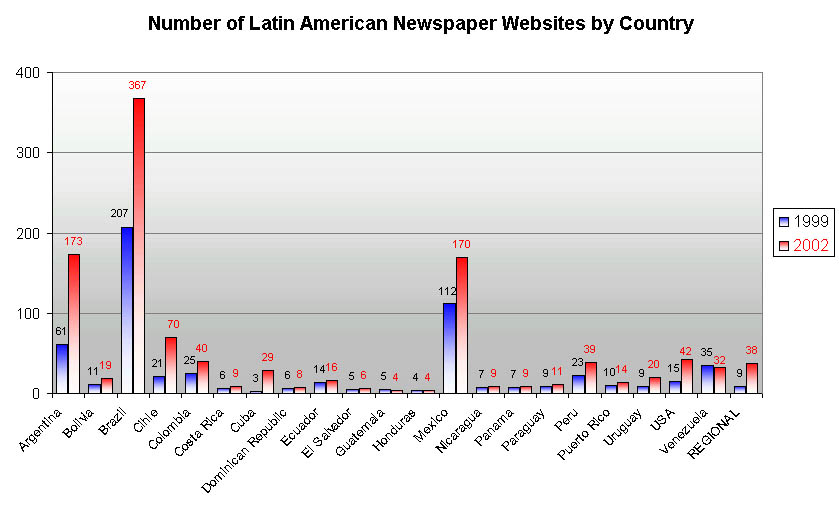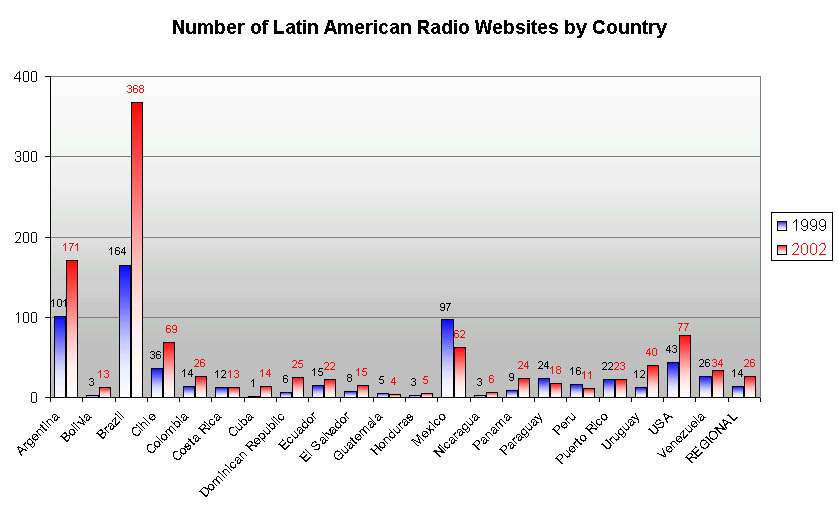Traditional Latin American
Media
on the Internet: Revisited
About three years ago, we published an article titled Traditional Latin American Media on the Internet. In that article, we showed the number of traditional media websites (that is, either newspaper, magazine, television or radio) that were listed on the Zona Latina website. Today, three years later, we revisit these same numbers and see if things have changed. We should point out these numbers refer solely to those websites that are listed in the Zona Latina directory. This is a directory that does not charge listing fees and so does not exhibit the biases that are associated with pay directories. The directory is compiled by us independently through multiple sources based upon our knowledge and experience. This directory will generally include any website that may be construed as a professional operation (minimally, a domain name). What this means that an irregularly updated news website that is hosted on a free server (such as geocities or cjb) will probably not be listed here, in order to spare our users from the dissatisfying experience of sorting through those types of listings.
What were our expectations? Actually, we were somewhat unsure.
On one hand, we know that there are more internet users in Latin American than ever before. The mystique, complexity and cost of website design, maintenance and hosting have also fallen dramatically. For these reasons, we would expect that just about any traditional media company would want to have a web presence.
On the other hand, it has been a couple of years since the euphoria of the late 1990's about the new economy has burst into a more sober reality. This is no longer a gold rush where everyone will get immensely rich. When a business model is carefully specified, it should be clear that most websites cannot be profitably sustained. For these reasons, we would have expect a period of realistic retrenchment in which the number of websites may actually decrease.
![]()
NEWSPAPERS
In 1999, we listed 604 newspaper websites. In 2002, we listed 1,129 newspaper websites, for an increase of 87%. In the smaller countries, where there are just a few large newspapers, the number of websites has stagnated and we do not expect to see any change in the future. The strongest growths were found in the four countries of Argentina, Brazil, Chile and Mexico, with large number of new websites coming from the newspapers in medium-sized cities. With the demystifying of the complexity and cost of web design/maintenance, it is now relatively easy for these newspapers to publish the content that they already prepare for their brick-and-mortar versions.

(source: Zona Latina)
![]()
RADIO
In 1999, we listed 634 radio websites. Today, we have 1,066 radio websites, for a 68% increase. Radio is therefore an area of strong growth. The increase did not occur uniformly across the countries. In the smaller countries, where there were few large radio stations, the number of websites seemed to have stagnated, and we do not foresee the situation being any different. Given the sizes of their markets and the potential web audience, these are their logical potentials. In Mexico, there are now fewer radio websites than before. The Mexican radio industry is concentrated into a few very large station groups, and this arrangement is inimical to the proliferation of individual radio websites. The largest growth in radio websites can be attributed to two countries: Argentina and Brazil (and we can also add Chile), where there are numerous independent radio stations.
An intriguing concept is the radio portal as exemplified by Sinfomusic in Panama, which serves the function of a radio set from which listeners can get to listen to a large number of radio stations who are not required to operate their own streaming services.

(source: Zona Latina)
![]()
TELEVISION
In 1999, we listed 549 television websites, including television channels and programs. Today, we have 514 television websites, for a decrease of 6%. At first blush, this is a surprising outcome. On further thought, this is not so shocking after all. The abandoned websites are those that are unable to maintain a fresh presence, to the point where they see a static website as being a liability to their brand names. Unlike newspapers, television content cannot be transferred via copy-and-paste operations from their brick-and-mortar counterparts. Unlike radio, television content cannot be streamed live as that experience does not compare well against watching the transmission on a television set. The only area of growth is in the regional television channels, where an economy of scale through the audience accumulated by a wide distribution network permits the preparation of top-quality websites.

(source: Zona Latina)
![]()
MAGAZINES
In 1999, we had 1,033 Latin American websites listed. Today, we have 1,329 magazine websites listed, for an increase of 29% increase. About 60% of this increase has come from two countries: Argentina and Brazil. The majority of these magazine websites are niche entities which do not appear in regular print form. Especially prominent are e-zines in areas auch as the arts, culture, music, politics and literature. Clearly, these new entries are inspired by the low cost of entry and operation, compared to the traditional print format. Within the magazine field, the overall traffic is likely still dominated by the major publishing groups (e.g. Abril in Brazil). However, the largest Spanish-language publishing group in Latin America, Editorial Televisa, still does not have a web presence.

(source: Zona Latina)
![]()
TOTAL MEDIA
In 1999, we listed 2,820 media websites for magazines, newpapers, radio and television. Today, we list 4,038 media websites for an increase of 43%. The largest increase are in the countries of Argentina, Brazil and Chile, as well as the regional sites. In those three countries, the growth has been driven by the emergence of new websites from the traditional newspaper and radio media in the small-and medium-sized cities. The case of Cuba, which went from 8 websites to 76 websites in three years is an anomaly, since those websites are largely operated by the state. Nevertheless, one has to commend Cuba for making a concerted effort to forge a strong presence on the World Wide Web.

(source: Zona Latina)
The 43% growth over three years is derived primarily from the traditional media (especially, newspapers and radio) in medium-sized cities (especially in Argentina and Brazil) and is built upon the low-cost re-purposing of existing content. Such websites cannot be expected to be operated profitably with the advertising revenue for 20,000 or so visits per year, which is perhaps the expected traffic for a local-interest website in a medium-sized city with a small number of internet users. They are possible only because they are subsidized by their brick-and-mortar operations.
As for the future, the business model that we have seen elsewhere is based upon the coalescing of the local websites into national networks which can provide national coverage with sizeable audiences for natioanl or pan-regional advertisers. In this way, the sum of the parts become larger than the parts.
And speaking as internet users, we don't think that we want to see a blooming in the sense of 5,000 more radio websites in the next 3 years. We want quality, not quantity, and we want a means of easily and reliably finding those quality websites.
(posted by Roland Soong, 9/27/2002)
(Return to Zona Latina's Home Page)